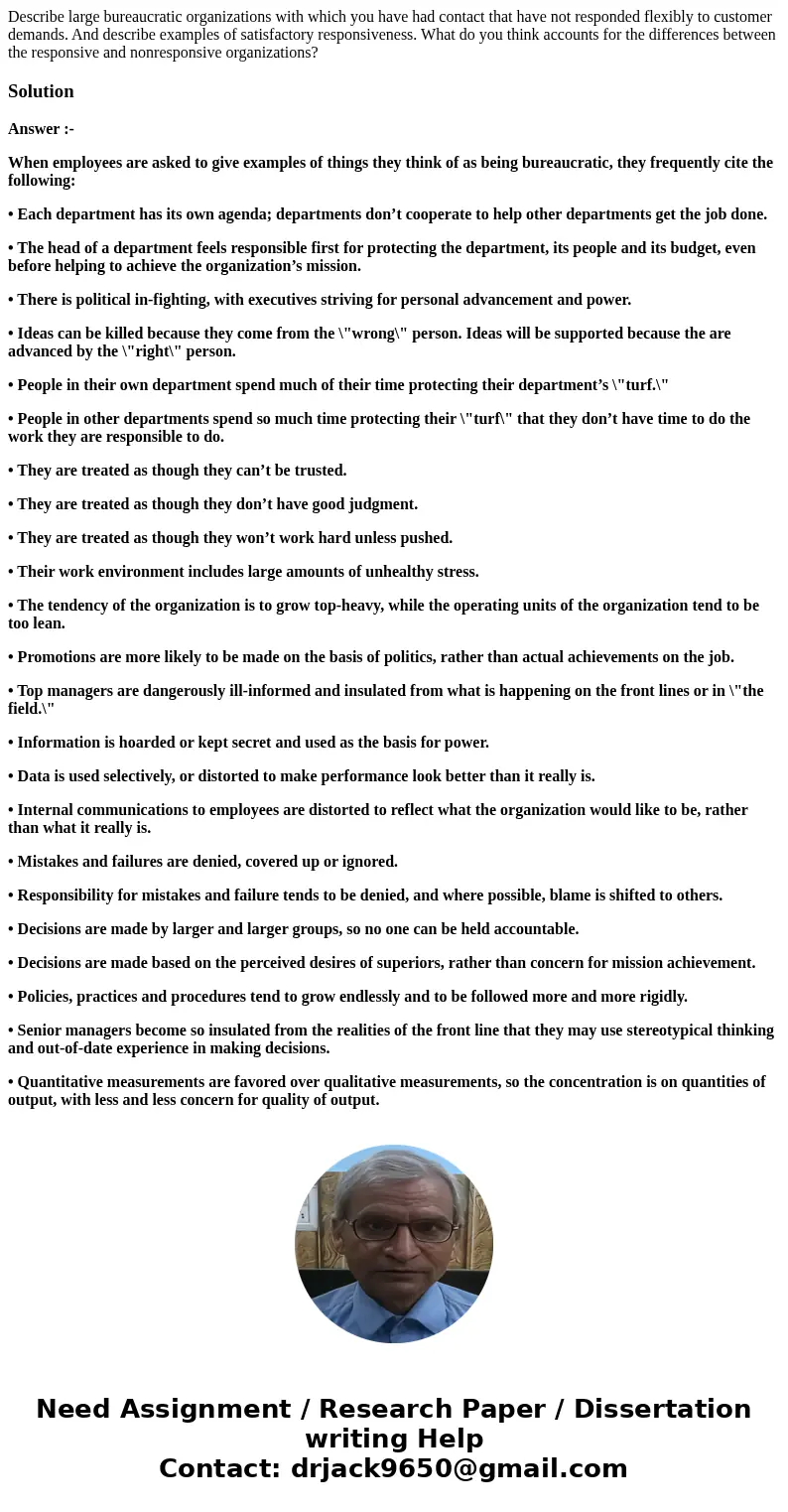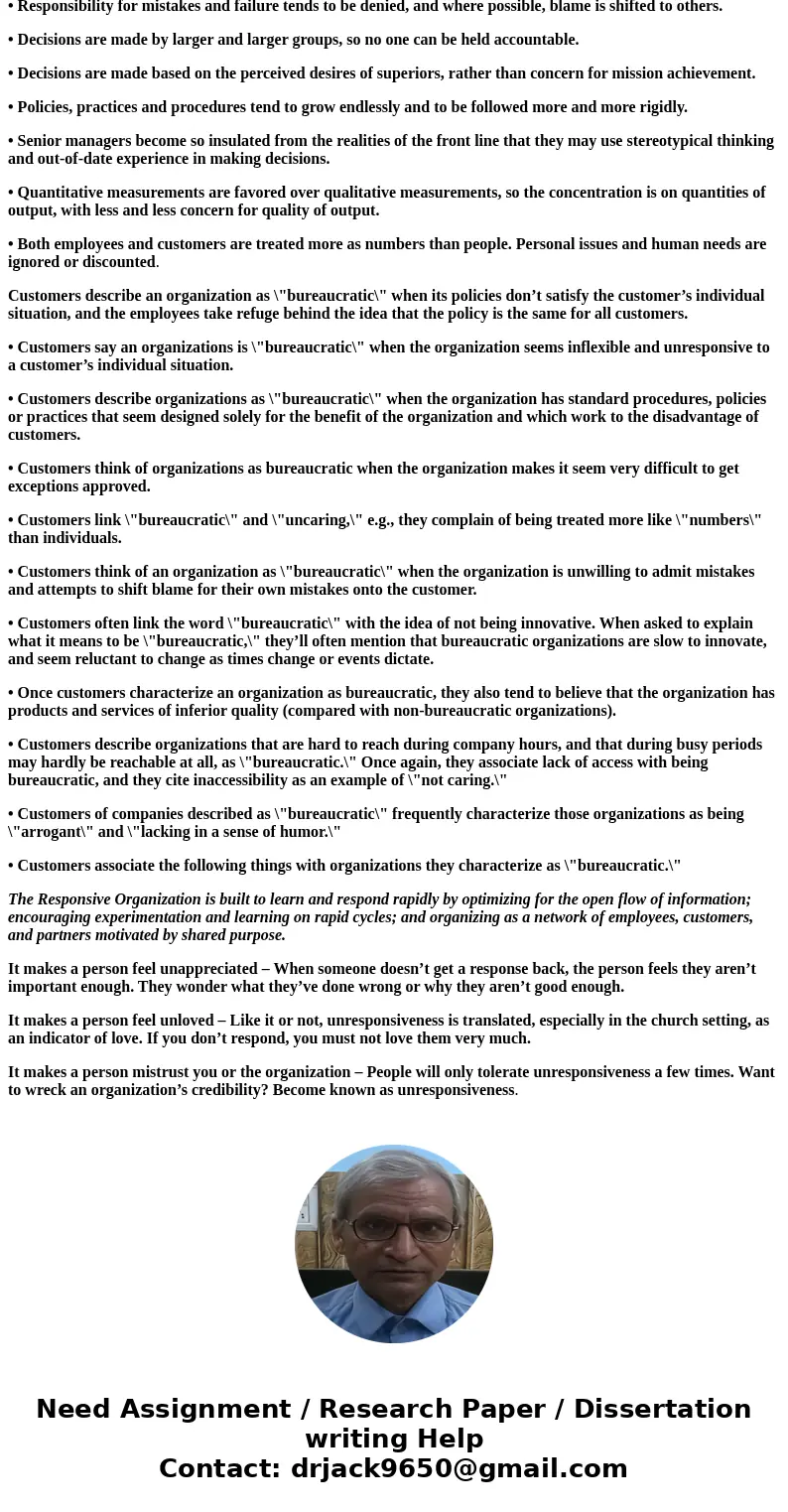Describe large bureaucratic organizations with which you hav
Describe large bureaucratic organizations with which you have had contact that have not responded flexibly to customer demands. And describe examples of satisfactory responsiveness. What do you think accounts for the differences between the responsive and nonresponsive organizations?
Solution
Answer :-
When employees are asked to give examples of things they think of as being bureaucratic, they frequently cite the following:
• Each department has its own agenda; departments don’t cooperate to help other departments get the job done.
• The head of a department feels responsible first for protecting the department, its people and its budget, even before helping to achieve the organization’s mission.
• There is political in-fighting, with executives striving for personal advancement and power.
• Ideas can be killed because they come from the \"wrong\" person. Ideas will be supported because the are advanced by the \"right\" person.
• People in their own department spend much of their time protecting their department’s \"turf.\"
• People in other departments spend so much time protecting their \"turf\" that they don’t have time to do the work they are responsible to do.
• They are treated as though they can’t be trusted.
• They are treated as though they don’t have good judgment.
• They are treated as though they won’t work hard unless pushed.
• Their work environment includes large amounts of unhealthy stress.
• The tendency of the organization is to grow top-heavy, while the operating units of the organization tend to be too lean.
• Promotions are more likely to be made on the basis of politics, rather than actual achievements on the job.
• Top managers are dangerously ill-informed and insulated from what is happening on the front lines or in \"the field.\"
• Information is hoarded or kept secret and used as the basis for power.
• Data is used selectively, or distorted to make performance look better than it really is.
• Internal communications to employees are distorted to reflect what the organization would like to be, rather than what it really is.
• Mistakes and failures are denied, covered up or ignored.
• Responsibility for mistakes and failure tends to be denied, and where possible, blame is shifted to others.
• Decisions are made by larger and larger groups, so no one can be held accountable.
• Decisions are made based on the perceived desires of superiors, rather than concern for mission achievement.
• Policies, practices and procedures tend to grow endlessly and to be followed more and more rigidly.
• Senior managers become so insulated from the realities of the front line that they may use stereotypical thinking and out-of-date experience in making decisions.
• Quantitative measurements are favored over qualitative measurements, so the concentration is on quantities of output, with less and less concern for quality of output.
• Both employees and customers are treated more as numbers than people. Personal issues and human needs are ignored or discounted.
Customers describe an organization as \"bureaucratic\" when its policies don’t satisfy the customer’s individual situation, and the employees take refuge behind the idea that the policy is the same for all customers.
• Customers say an organizations is \"bureaucratic\" when the organization seems inflexible and unresponsive to a customer’s individual situation.
• Customers describe organizations as \"bureaucratic\" when the organization has standard procedures, policies or practices that seem designed solely for the benefit of the organization and which work to the disadvantage of customers.
• Customers think of organizations as bureaucratic when the organization makes it seem very difficult to get exceptions approved.
• Customers link \"bureaucratic\" and \"uncaring,\" e.g., they complain of being treated more like \"numbers\" than individuals.
• Customers think of an organization as \"bureaucratic\" when the organization is unwilling to admit mistakes and attempts to shift blame for their own mistakes onto the customer.
• Customers often link the word \"bureaucratic\" with the idea of not being innovative. When asked to explain what it means to be \"bureaucratic,\" they’ll often mention that bureaucratic organizations are slow to innovate, and seem reluctant to change as times change or events dictate.
• Once customers characterize an organization as bureaucratic, they also tend to believe that the organization has products and services of inferior quality (compared with non-bureaucratic organizations).
• Customers describe organizations that are hard to reach during company hours, and that during busy periods may hardly be reachable at all, as \"bureaucratic.\" Once again, they associate lack of access with being bureaucratic, and they cite inaccessibility as an example of \"not caring.\"
• Customers of companies described as \"bureaucratic\" frequently characterize those organizations as being \"arrogant\" and \"lacking in a sense of humor.\"
• Customers associate the following things with organizations they characterize as \"bureaucratic.\"
The Responsive Organization is built to learn and respond rapidly by optimizing for the open flow of information; encouraging experimentation and learning on rapid cycles; and organizing as a network of employees, customers, and partners motivated by shared purpose.
It makes a person feel unappreciated – When someone doesn’t get a response back, the person feels they aren’t important enough. They wonder what they’ve done wrong or why they aren’t good enough.
It makes a person feel unloved – Like it or not, unresponsiveness is translated, especially in the church setting, as an indicator of love. If you don’t respond, you must not love them very much.
It makes a person mistrust you or the organization – People will only tolerate unresponsiveness a few times. Want to wreck an organization’s credibility? Become known as unresponsiveness.


 Homework Sourse
Homework Sourse